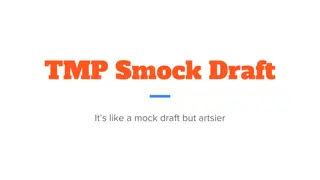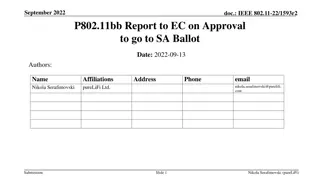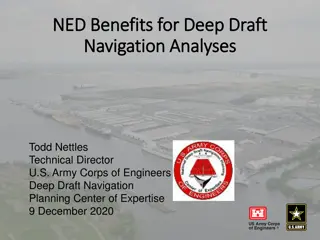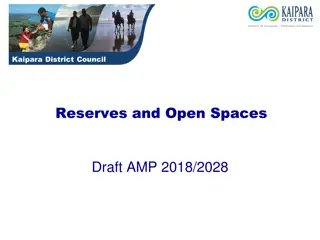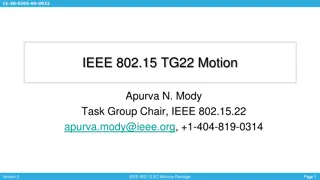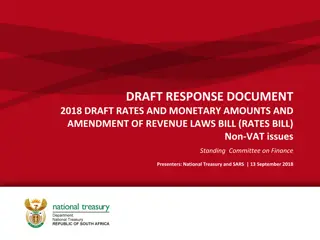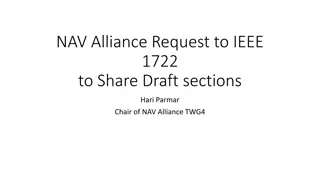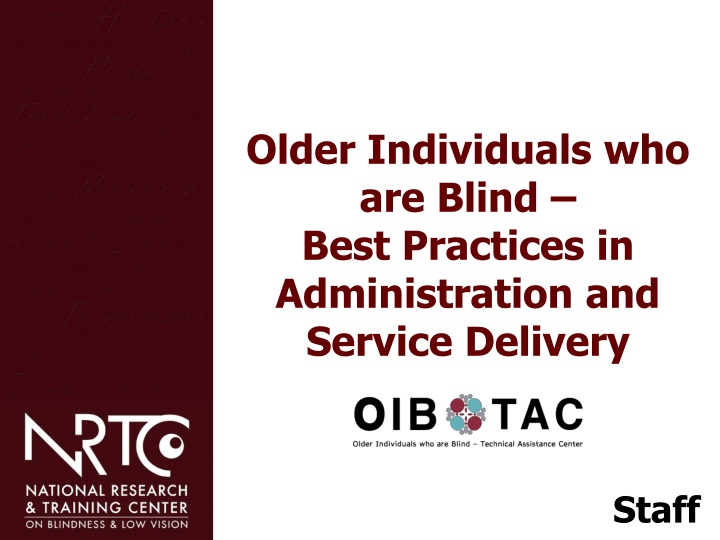
Effective Administration and Service Delivery Practices for Older Individuals Who Are Blind
Explore best practices and task force areas for administering services to older individuals who are blind. Learn about the history of the project, composition of the task force, and the definition of best practices in service delivery. Discover the goals, learning objectives, and purpose of the OIB Program Task Force.
Download Presentation

Please find below an Image/Link to download the presentation.
The content on the website is provided AS IS for your information and personal use only. It may not be sold, licensed, or shared on other websites without obtaining consent from the author. If you encounter any issues during the download, it is possible that the publisher has removed the file from their server.
You are allowed to download the files provided on this website for personal or commercial use, subject to the condition that they are used lawfully. All files are the property of their respective owners.
The content on the website is provided AS IS for your information and personal use only. It may not be sold, licensed, or shared on other websites without obtaining consent from the author.
E N D
Presentation Transcript
Older Individuals who are Blind Best Practices in Administration and Service Delivery Staff
Learning Objectives Best practice in the context of the OIB Program. Best practice outcomes of the OIB Best Practice Task Force. Moving toward best practice in the administration of state OIB programs. blind.msstate.edu blind.msstate.edu PAGE 2
History of the Project The goals of the OIB-TAC federal grant The forming of the Best Practices Task Force The goal of the Task Force Moving toward best practice in the administration of state OIB programs blind.msstate.edu blind.msstate.edu PAGE 3
Composition of the Task Force 7 DSA Program Managers and former Program Managers including two State Directors Multi-disciplinary: O&M, Vision Rehabilitation Therapy, Low Vision, Social Work, Deaf- Blindness, Occupational Therapy, Non-Profit Management, and Aging Published authors, university personnel, researchers, distance education experts, curriculum developers, diverse approaches, mid- level administrators, national and local perspectives blind.msstate.edu blind.msstate.edu PAGE 4
OIB Best Practice Definition Best practices are service delivery strategies or techniques that appear effective based on available evidence; are client-centered; are sensitive to the context of the service delivery setting; and are responsive to evolving technology, resources, and/or research (OIB-TAC, 2017). blind.msstate.edu blind.msstate.edu PAGE 5
Purpose/Goal Come to consensus on best, acceptable, and non-acceptable practice in service delivery associated with OIB programs blind.msstate.edu blind.msstate.edu PAGE 6
OIB Best Practices Task Force Areas Implementing an Effective Program Qualified Personnel Program Management blind.msstate.edu blind.msstate.edu PAGE 7
Procedure-Groups Divide experts into groups Assign a facilitator and note taker to each subgroup Merge groups and reach concensus until the entire group agrees. Note dissenting opinions Discussion lively at each step! blind.msstate.edu blind.msstate.edu PAGE 8
Procedure - Document NRTC staff edited drafts based on feedback from group Revised drafts submitted to groups of 8 for feedback Further revisions made and revised drafts submitted to the group of 16 Revisions made and drafts submitted to two outside reviewers (Bernard Steinman and John McMahon) NRTC added introduction, formatting, and concluding remarks. blind.msstate.edu blind.msstate.edu PAGE 9
Areas explored by the Best Practice Task Force blind.msstate.edu blind.msstate.edu PAGE 10
Levels Best practice Acceptable Practice - Any agency that does not implement best practices will have a plan in place to move toward best practices that includes an expeditious timetable and benchmarks. Unacceptable Practice Lacks in securing the integrity of the program, or the safety or best interests of staff or consumers. blind.msstate.edu blind.msstate.edu PAGE 11
Area 1: Implementing an Effective Program 1. Program management 2. Consumer eligibility 3. Prioritizing consumers 4. Managing cost of assistive devices 5. Prioritizing assistive devices provided 6. Cultural competency 7. Community outreach 8. Use of para-professionals and volunteers blind.msstate.edu blind.msstate.edu PAGE 12
Check out Two of the Task Forces Best Practice Focus Areas Program Management Service Delivery blind.msstate.edu blind.msstate.edu PAGE 13
Program Management- Best Practice The manager of the state OIB program must have the leadership and administration skills to oversee the OIB program and maintain rigorous control over all aspects of service delivery, including the ability to recognize and support qualified staff. The program manager will develop, in conjunction with designated stakeholders, a strategic plan that includes short and long-term programmatic goals, timelines for service implementation, and procedures for program evaluation. blind.msstate.edu blind.msstate.edu PAGE 14
Program Management - BP The program manager will ensure that service providers, whether employed by the agency or by contract, are appropriately licensed or certified, have clear deliverables with appropriate timelines, and adhere to a quality assurance process. The program manager will ensure compliance with all federal guidelines for the program, support program evaluation, and engage in activities to promote quality service delivery. The program manager will attend the annual OIB program managers meeting. blind.msstate.edu blind.msstate.edu PAGE 15
Program Management - BP cont When direct services are provided (beyond information and referral), regardless of service delivery model, the program manager will ensure that service providers conduct functional assessments and develop individual service plans, with consumer input, consistent with issues identified by the assessment. The program manager will ensure that individual staff training plans are developed and that those plans address individual or programmatic goals and support staff licensure or certification. Agency resources will support development activities for staff to obtain or retain appropriate licensure/certification. blind.msstate.edu blind.msstate.edu PAGE 16
Program Management Other levels Acceptable Practices Any agency that does not implement best practices will have a plan in place to move toward best practices that includes an expeditious timetable and benchmarks. Unacceptable Practices When there is no plan to move toward best practices, or when that plan is not executed in a timely manner, the practice is unacceptable. Failure to adhere to federal guidelines, maintain appropriate oversight of contracted services, or facilitate service delivery by qualified personnel are also unacceptable. blind.msstate.edu blind.msstate.edu PAGE 17
Service Delivery - BP Quality intake services are critical to identifying consumer needs, so intake workers can refer consumers for assessment by the appropriate discipline-specific provider. A discipline-specific qualified professional (CVRT, NCRTB, COMS, NOMC, OT, CRCC, CLVT, etc.) will conduct a thorough assessment, recommend and/or provide specialized services, and suggest additional referrals, as appropriate. Individual consumer services should be prioritized based on professional assessments. In a resource-constricted environment, the primary service should be information and referral. Everyone in the agency will be able to provide basic information and referral services. Staff will refer consumers who indicate an interest in or respond positively to suggestions about potential employment to VR counselors trained to assess and work with older consumers. blind.msstate.edu blind.msstate.edu PAGE 18
Service Delivery - BP cont Agency staff will contact the state deafblind coordinator or the Helen Keller National Center regional representative when consumers have dual sensory impairment (deafblind). OIB staff will inform consumers about the clinical services and devices available in the marketplace, regardless of whether or not the program can provide those services or devices. The program manager will ensure that a resource list, which includes local, state, and national resources to help adjust to and cope with vision loss, is readily available in various formats to meet consumer needs. blind.msstate.edu blind.msstate.edu PAGE 19
Service Delivery - other Acceptable Practices Acceptable practices always include a plan to achieve best practices, including benchmarks and timelines. When necessary services are not available, the agency must provide appropriate information and referral. Unacceptable Practices It is unacceptable to put consumers at risk due to lack of services. It is unacceptable to fail to provide appropriate information and referral services. It is unacceptable for unqualified personnel to provide services. It is unacceptable to provide services that are not based on individualized consumer functional assessments. blind.msstate.edu blind.msstate.edu PAGE 20
Area 2: Managing an OIB Program Areas 1. Program models 2. Program evaluation 3. Advisory council 4. Occupational therapy services blind.msstate.edu blind.msstate.edu PAGE 21
Area 3: Qualified Staff Areas 1. Qualifications of professional staff 2. Staff education and continuing education 3. Staff recruitment and retention 4. Qualifications of paraprofessionals blind.msstate.edu blind.msstate.edu PAGE 22
Whats Next? Community of Practice On-Line Training www.OIB-TAC.org Other OIB-TAC resources blind.msstate.edu blind.msstate.edu PAGE 23
References Patton, M.Q. (1987). Qualitative Research Evaluation Methods. Thousand Oaks, CA: Sage Publishers. blind.msstate.edu blind.msstate.edu PAGE 24
For more information, please contact the NRTC: B. J. LeJeune Kendra Farrow Bill Tomlin Adele Crudden Sophie Kershaw Phone: 662.325.2001 Fax: 662.325.8989 Websites: blind.msstate.edu ntac.blind.msstate.edu Social Media: www.facebook.com/msu.nrtc www.twitter.com/msu_nrtc






